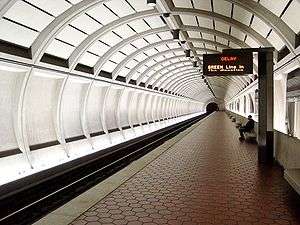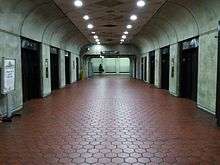Forest Glen station
Forest Glen is a side platformed Washington Metro station in Forest Glen, Maryland, United States. The station was opened on September 22, 1990, and is operated by the Washington Metropolitan Area Transit Authority (WMATA).[1][4] Its opening coincided with the completion of 3.2 miles (5.1 km) of rail north of the Silver Spring station and the opening of the Wheaton station.[1][4][5] Providing service for the Red Line, the station is located at Georgia Avenue (Maryland Route 97) and Forest Glen Road. The station is the deepest in the system at 196 feet (60 m) deep, so high-speed elevators, rather than escalators, are used for access to the surface.[1] A free shuttle run by the Church of Jesus Christ of Latter-day Saints operates in between the station and the Washington DC Temple near the Capital Beltway. There is also a shuttle serving the Holy Cross Hospital.
Forest Glen | |||||||||||
|---|---|---|---|---|---|---|---|---|---|---|---|
 | |||||||||||
| Location | 9730 Georgia Avenue, Forest Glen, Maryland | ||||||||||
| Coordinates | 39.0153°N 77.0430°W | ||||||||||
| Owned by | WMATA | ||||||||||
| Platforms | twin tube inter-connected side platforms | ||||||||||
| Tracks | 2 | ||||||||||
| Connections | |||||||||||
| Construction | |||||||||||
| Structure type | Underground | ||||||||||
| Depth | 196 feet (60 m) | ||||||||||
| Parking | 592 spaces[1] | ||||||||||
| Bicycle facilities | 42 racks, 16 lockers | ||||||||||
| Disabled access | Yes | ||||||||||
| Other information | |||||||||||
| Station code | B09 | ||||||||||
| History | |||||||||||
| Opened | September 22, 1990[2] | ||||||||||
| Traffic | |||||||||||
| Passengers (2017) | 2,126 daily[3] | ||||||||||
| Services | |||||||||||
| |||||||||||
History

The original plan was to build the station above ground, with a parking lot that would have required demolishing about fifteen homes.[6] After community opposition to the above-ground station, Montgomery County approved a modified plan for an underground station.[6]
The originally planned location for the parking lot and bus stops was on the east side of Georgia Avenue, between Sherwood Road and Tilton Drive, near Woodland Drive.[7] Tilton Drive would have been closed between Georgia Avenue and Woodland Drive in order to reduce traffic through the nearby residential neighborhood.[7] Building the parking lot and bus stops there would have required the demolition of one business and several homes.[7]
Response to plans for the underground station were mixed, with some residents and local businesses looking forward to the convenience of a nearby station and other residents concerned about potential increases in traffic in the area.[1][6] Metro contended that deleting the station from the plans altogether would have overloaded both Wheaton and Silver Spring metro stations.[7] The Montgomery County council approved the station in January 1976,[6] three months after it had approved the further-away Wheaton station.[8]
Station layout
Due to tracks resting at a depth of 196 feet (60 m), Forest Glen is the only station in the system without direct surface access by way of escalators.[4] Instead, a bank of six high-speed elevators that travel at a rate of 17 feet per second (5.2 m/s) between the underground station and the surface.[9] In addition, a 20-story staircase exists for emergency use. Because of the lack of escalators, Forest Glen is the only station equipped with smoke doors to protect customers during a train fire and evacuation.[4] Building the tunnels through soft rock close to the surface would have been either very costly or impossible, so engineers decided to dig the tunnels through harder, more solid rock deeper in the ground.[1][7]
Another architectural feature of this station is separate tunnels and side platforms for each direction, instead of the large, vaulted common room seen at most other underground Metro stations.[10] This design, shared with Wheaton station, was used because it was cheaper than building a larger two-tracked station with a larger base and higher vaulted ceilings.[4][10]
| G | Street level | Exit/entrance, buses, parking; fare control, ticket machines, station agent |
| P Platform level |
Westbound | ← |
| Side platform | ||
| Side platform | ||
| Eastbound | | |
References
- Fehr, Stephen C. (September 16, 1990). "Wheaton, Forest Glen To Climb Aboard Metro: New Stations to Extend Red Line 3.2 Miles". The Washington Post. p. D1. ProQuest 307320514. Article preview
- Hill, Retha (September 18, 1990). "Metro Station Divides Forest Glen Residents: Impact on Century-Old Community an Issue". The Washington Post. p. D07. ProQuest 307295207.Article Preview
- "Metrorail Average Weekday Passenger Boardings" (PDF). WMATA. May 2016. Retrieved July 31, 2018.
- Fehr, Stephen C. (September 23, 1990). "Metro Adds 2 Stations To System; Wheaton, Forest Glen Open for Thousands". The Washington Post. p. D4.
- "Sequence of Metrorail openings" (PDF). WMATA. 2017. p. 3. Archived from the original (PDF) on July 2, 2018. Retrieved April 1, 2018.
- "County Approves Forest Glen Stop". The Washington Post. January 14, 1976. p. B2. ProQuest 146406605. Article preview
- Eisen, Jack (April 14, 1975). "Public Hearings Set On Metro Stop Shift In Montgomery County". The Washington Post. p. C3. ProQuest 146427745.
- "County Council Decides On Wheaton Metro Site". The Washington Post. October 8, 1975. p. A9. ProQuest 146339453. Article preview
- Levy, Claudia (November 6, 1989). "New Metro Stop Is Way Down Under: Curious in Md. Take Preview Plunge Into Area's Deepest Station". The Washington Post. p. B03. ProQuest 307231764. Article preview Article blurb
- Burgess, John (November 4, 1981). "Jumbo Bores Metro Tunnel: Transit Agency Racing Against Reagan Funds Slash". The Washington Post. p. C1. ProQuest 147326196. Article preview
External links

- WMATA Forest Glen station page
- StationMasters page for Forest Glen station (map incorrectly shows two extra elevators)
- Forest Glen Road entrance from Google Maps Street View